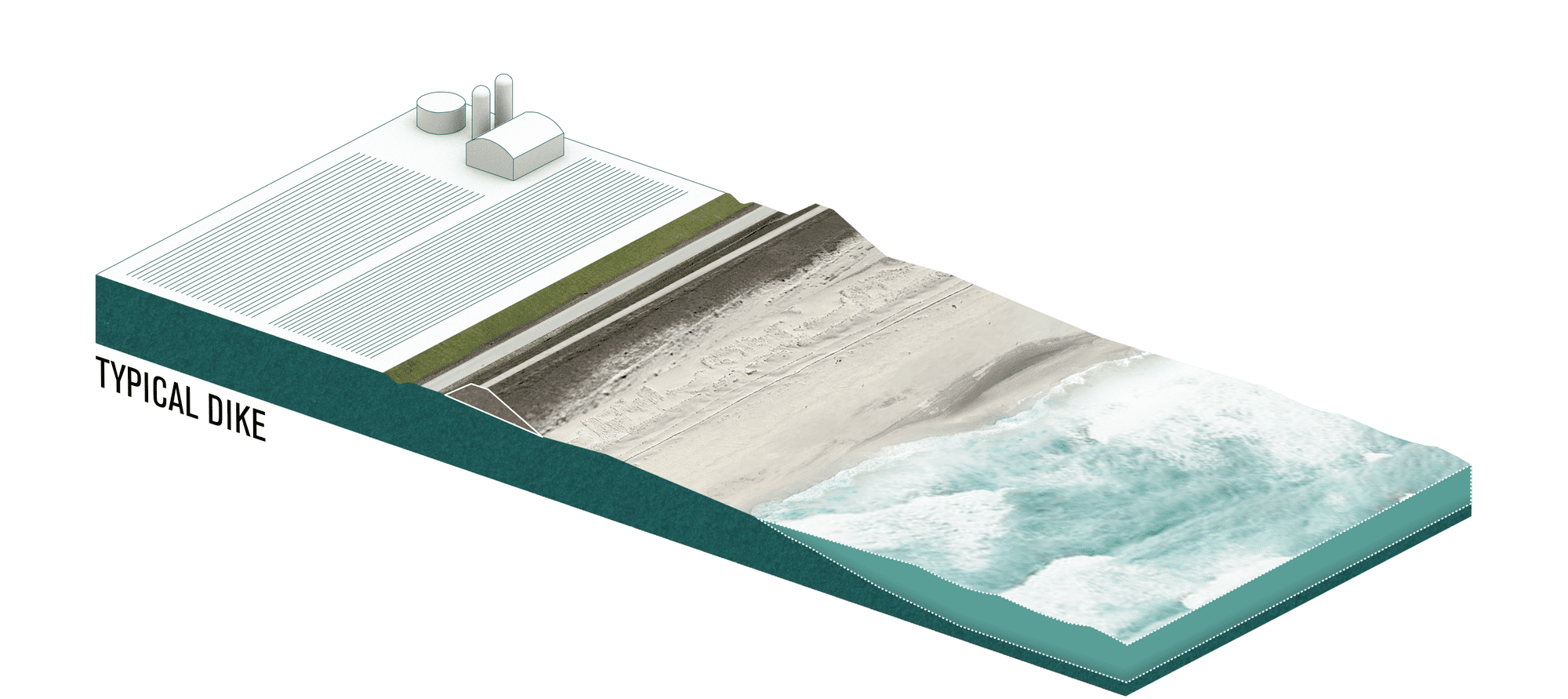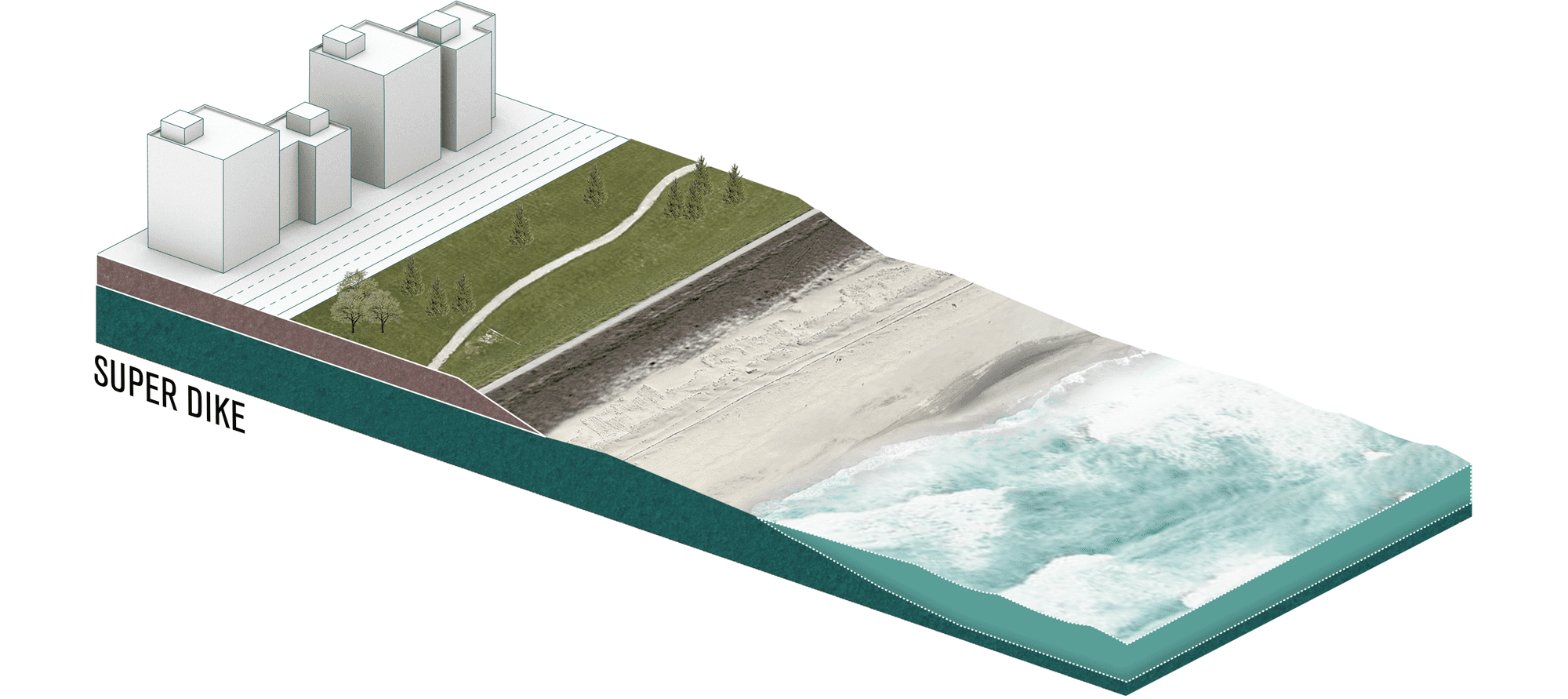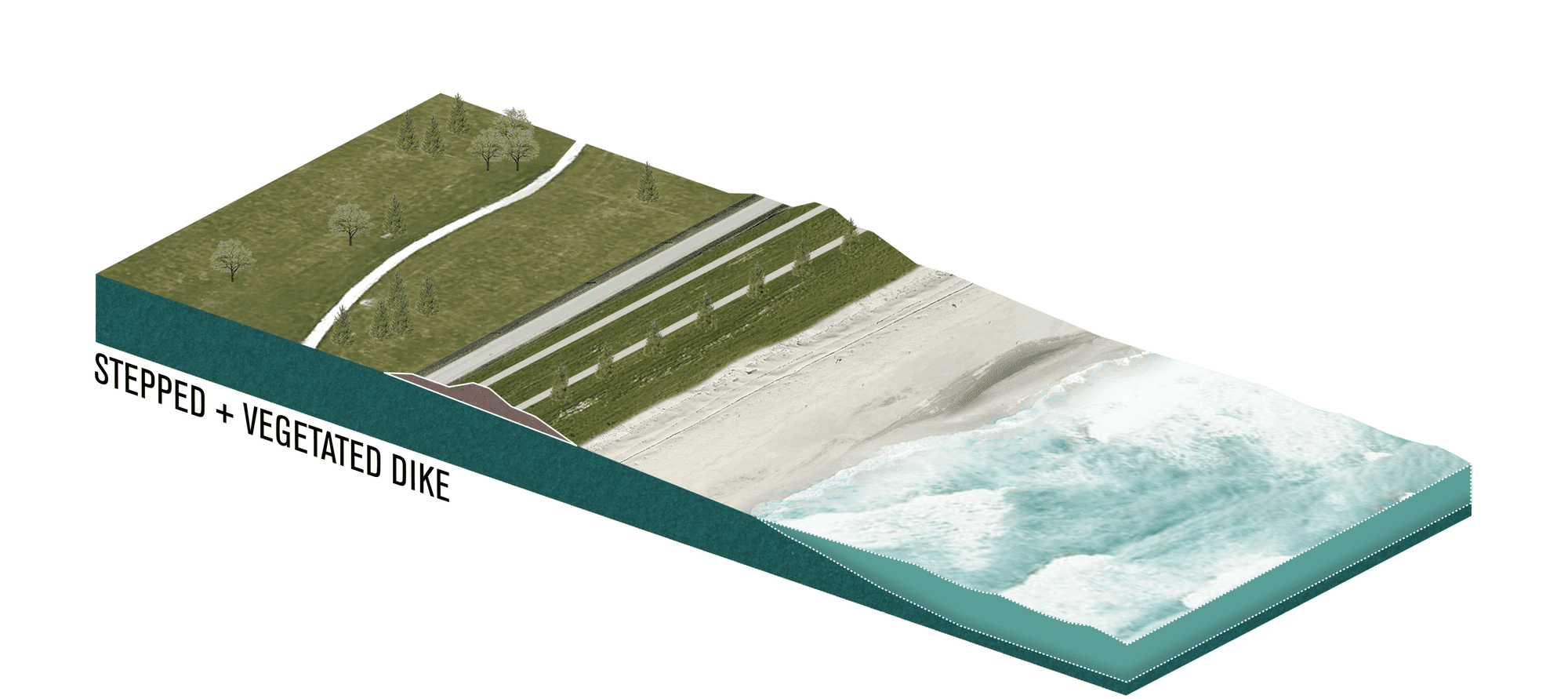Adaptation Strategy: Dikes
Dikes are linear compacted earth structures implemented to protect coastal areas from flooding.1 Because dikes are built with a high volume of compacted earth, they are efficient in resisting high water pressure, wave loadings, and overtopping.2 Traditionally, dike construction consists of a sand core, an outer watertight protection layer, toe protection, and a back drainage channel.3 These structures are unique in their typologies and can be designed to enhance the economic, recreational, and ecological value of the coastline. Currently, research is being conducted on how dikes can be more successfully integrated within the landscape and potentially increase the multifunctionality and robustness of dikes while reducing breaches.
How it works
Types of dikes
- Superdikes have a high embankment, a wide base, and a gentle slope. They are usually larger than a standard dike and are designed to withstand earthquakes, erosion, and breaches. Super dikes are designed for water to flow slowly during overtopping. They are also designed to function in low lying urban areas. Hence, they are multifunctional in that they incorporate protection measures for residential, commercial, and recreational spaces. 10
- A double dike: the essential feature of a double dike is that the primary dike is not raised thus allowing water to flow over during storm-like weather. A second dike further inland is designed to contain the flow of water over the first dike. 11
- A triple dike has a 3-zone defense structure, a front, central and back zone. The central zone acts as a multifunctional dike. The back zone manages water and rainwater runoff while the front zone decreases the impact of waves. 12
- “The bionic dike is a concept proposal to reinterpret water safety as 100 percent adaptive.” In this concept the dike has no rigid height, instead, the dike landscape adjusts to environmental changes over time. Developed for the city of In Wageningen the dike is designed to move with the water. When the tide is low the dike opens, when the tide is high the water pressure causes the dike to rise thereby protecting the city. 13
Benefits
- Prevents flooding in low lying coastal areas
- The sloped seaward edge of the dike reduces wave loading and improves wave energy dissipation
- Protects of value development against coastal flooding
- Reduces the effects of coastal erosion by reducing wave energy.
- Reduced toe scour given that the down rush of the wave is directed away from the structure. This reduces the risks associated with undermining.
Challenges
- Expensive to construct and requires high maintenance
- Structural integrity decreases over time due to storm damage
- Require large volumes of building materials.
- Requires a large area of land to facilitate the shallow slopes that are needed to aid in wave dissipation.
- Results in fixing the position of the coastline thereby disrupting natural geomorphological processes 14
Example projects
Delta Works
The Netherlands
Delta Works is a series of flood protection construction projects that were implemented along the Dutch coast in response to the devastating flood of 1953.4 Part of the engineering works was the construction and reinforcement of numerous dikes and levees that have completely changed the Dutch landscape and have become a cultural and historical part of the landscape.5 With the increase in research on climate change and sea-level rise, the Delta committee has initiated long-term plans for the reinforcement of the current flood protection structures. The plan incorporates two approaches: ‘building with nature’ and ‘room for the river’.6 This can be seen in the recent projects: The Sand Engine and The Hondsbossche Dunes, which are intended to reinforce the existing dikes through the concept of working with natural coastal dynamics. Given its scope and significance, Delta Works was designated by the American Society of Civil Engineers as one of the Seven Wonders of the Modern World.
Richmond Dike System
Richmond BC, Canada
The City of Flood Protection Management Strategy and Dike Master Plans serve as a guiding framework for continual upgrades and improvements to address climate change-induced sea-level rise. The Richmond Dike System was originally constructed in 1860 and surrounds the Lulu and Sea Islands.7 The dike system is an important feature of the settlement of Richmond where it was utilized to protect residential, agricultural, and industrial lands from inundation.8 The dikes have also become a landmark with the integration of recreational trails, vegetation, and structural elements (docks and bridges) known today as the West and South Dyke Trail.9 Although these trails offer beautiful views of British Columbia’s coastal landscape, the structural integrity of the current dike system might be affected by climate change and sea-level rise. In response, the City of Richmond is exploring current plans to upgrade the dike system.
Citations
-
1.
↑
The Arlington Group Planning Architecture Inc., et al. Sea Level Rise Adaptation Primer. pp. 64. https://www2.gov.bc.ca/assets/gov/environment/climate-change/adaptation/resources/slr-primer.pdf
-
2.
↑
Zhu, Xianli, et al. Technologies for Climate Change Adaptation - Coastal Erosion and Flooding. 2010, pp. 47. https://orbit.dtu.dk/files/5699563/Technologies for Climate Change Adaptation-Coastal Erosion and Flooding.pdf.
-
3.
↑
Ibid, 47.
-
4.
↑
Kabat, Pavel, et al. Dutch Coasts in Transition. Nature Geoscience, July 2009, pp. 450. https://www.researchgate.net/publication/46383972_Dutch_Coasts_in_Transition.
-
5.
↑
Ibid, 451.
-
6.
↑
Ibid, 451.
-
7.
↑
“Dyke System.” City of Richmond BC - Dyke System, https://www.richmond.ca/plandev/planning2/heritage/HeritageInv/details.aspx?ID=161.
-
8.
↑
Ibid.
-
9.
↑
Ibid.
-
10.
↑
Floodwise in BC’s Lower Mainland. 2020. Super Dikes. https://floodwise.ca/reduce-the-risk/infrastructure-works/super-dikes/
-
11.
↑
De Ingenieur. 2018. DOUBLE DIKE ALONG THE EEMS. https://www.deingenieur.nl/artikel/double-dike-along-the-eems
-
12.
↑
Netherlands water partnership. News. 2020. ‘Triple dike’ design aids Shenzhen coastal resilience. https://www.netherlandswaterpartnership.com/news/triple-dike-design-aids-shenzhen-coastal-resilience
-
13.
↑
Civic Public Architecture. BIONIC DIKE WAGENINGEN. https://www.civicarchitects.eu/projects/bionische-dijk-wageningen
-
14.
↑
Climate Technology Centre and Network. CONNECTING COUNTRIES TO CLIMATE TECHNOLOGY SOLUTIONS https://www.ctc-n.org/technologies/dikes
-
i1.
↑
Dutch Dikes. http://dutchdikes.net/wp-content/uploads/2014/12/Hondsbossche-Zeewering-20140601-DSC04137.jpg.
-
i2.
↑
Figure 1. van Loon-Steensma, J. M., & Vellinga, P. (2014). Robust, multifunctional flood defenses in the Dutch rural riverine area. Natural hazards and earth system sciences, 14(5), 1085.https://www.researchgate.net/publication/307711013_Robust_multifunctional_flood_defenses_in_the_Dutch_rural_riverine_area/figures?lo=1&utm_source=google&utm_medium=organic
-
i3.
↑
Figure 2. Delta works. https://www.dutchwatermanagement.com/delta-works-1997-netherlands
-
i4.
↑
Figure 3. Richmond News. Richmond's $300 million dyke plan forges ahead https://www.richmond-news.com/news/richmond-s-300-million-dyke-plan-forges-ahead-1.15299874


